10.09.2025
SpaceX test fires next Super Heavy booster for Starship's 11th upcoming launch
The company is hoping to keep their momentum.
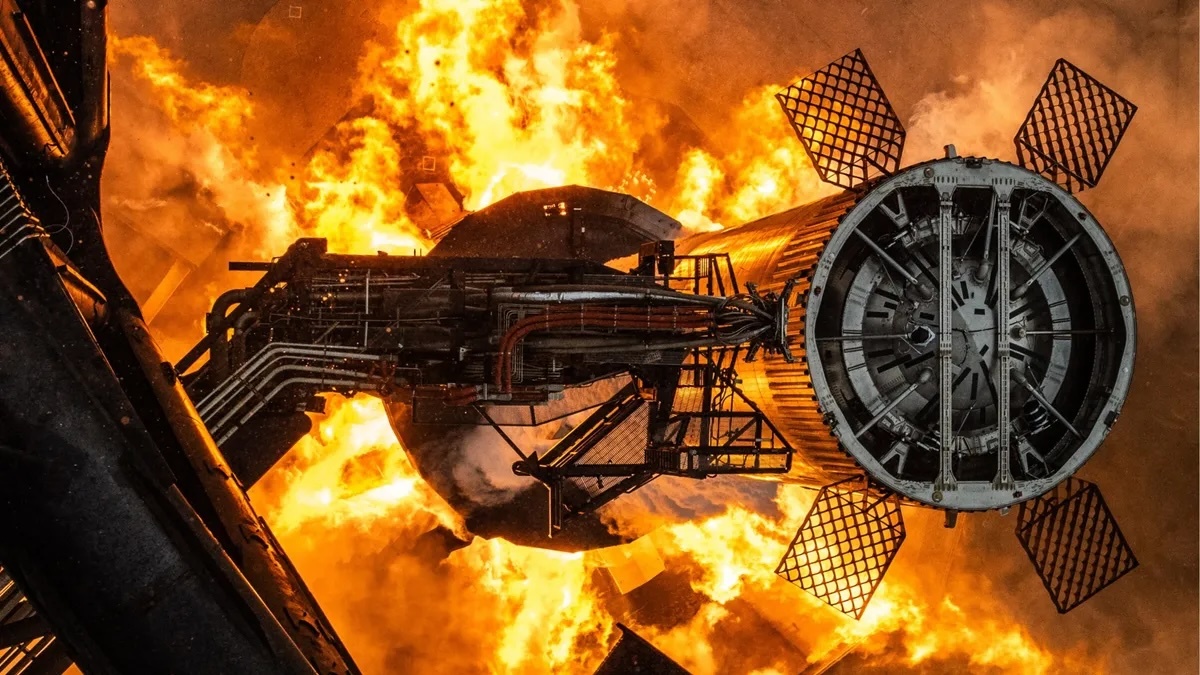
SpaceX conducts a static-fire test with the Flight 11 Starship Super Heavy B15 at its Starbase site in South Texas on Sept. 7, 2025. (Image credit: SpaceX)
With a rousing success under its belt from its last test flight, SpaceX is now preparing for the next launch of its giant Starship rocket.
The company performed a static test fire of the Super Heavy booster slated for Starship's 11th launch. Secured to the launch stand at SpaceX's Starbase manufacturing and test facility in Texas, the booster, B15, fired its 33 Raptor engines for about 10 seconds Sunday, Sept. 7, which was posted in videos on SpaceX's profile on X.
The test comes less than two weeks after Starship's Flight Test 10, which, for the first time, completed each of its objectives in a major win for SpaceX as they develop the rocket for operational missions.
Boosters are typically test fired in the days and weeks leading up to launches, and are part of final assessments to ensure vehicle safety ahead of liftoff. This test signals a quick turnaround for SpaceX as it prepares Starship for Flight Test 11.
SpaceX sought a similar cadence before Flight 10, but mishaps during Starship's upper stage testing for Ship 36 caused an explosion on the test stand during cryogenic fueling. The delay bumped Ship 37 up in the line, slating it to fly Starship's most successful flight to date.
Flight 10 lifted off from Starbase on Aug. 26. The stacked vehicle executed a successful hot-stage separation between Super Heavy and Ship, resulting in the booster's soft splashdown, and Ship's orbital insertion, payload deployment, atmospheric reentry and soft splashdown of its own in the Indian Ocean.
Flight 10's achievements were a significant step forward for the stalled program, and this weekend's B15 Super Heavy static fire engine test puts SpaceX on an pace to possibly launch Starship Flight Test 11 before the end of the month.
The test marked a welcome victory for SpaceX and the budding launch vehicle, which suffered in-flight upper stage explosions during each of this year's three Starship launches leading up to Flight 10. Those mishaps dealt a blow to SpaceX's development timeline for Starship, which has been promised to be operational in time for NASA's Artemis 3 moon mission.
Starship is contracted as Artemis 3's Human Landing System (HLS), tasked with landing the first astronauts on the moon since the final Apollo mission in 1972. NASA's new lunar program currently has Artemis 3 slated for 2027, but whether Starship will be ready in time is uncertain.
The launch vehicle was recently criticized by former NASA Administrator Jim Bridenstine, during a Senate Committee hearing on Sept. 3, during which he cited Starship's several unfulfilled milestones left on its plate.
Starship can't get to the moon all on its own. By the time it gets to orbit, the vehicle will have exhausted too much fuel to make trip. To help it reach the moon, SpaceX is planning up to a dozen additional Starship launches to refuel the Artemis 3 lunar lander in orbit, but hasn't yet demonstrated transferring the cryogenic fuel between vehicles. In fact, no one has ever done that.
SpaceX also needs to successfully land Starship on the moon for an uncrewed demonstration mission before NASA will qualify the vehicle for astronauts.
Quelle: SC
----
Update: 25.09.2025
.
SpaceX fires up Starship spacecraft ahead of 11th test flight
Flight 11 could happen soon.
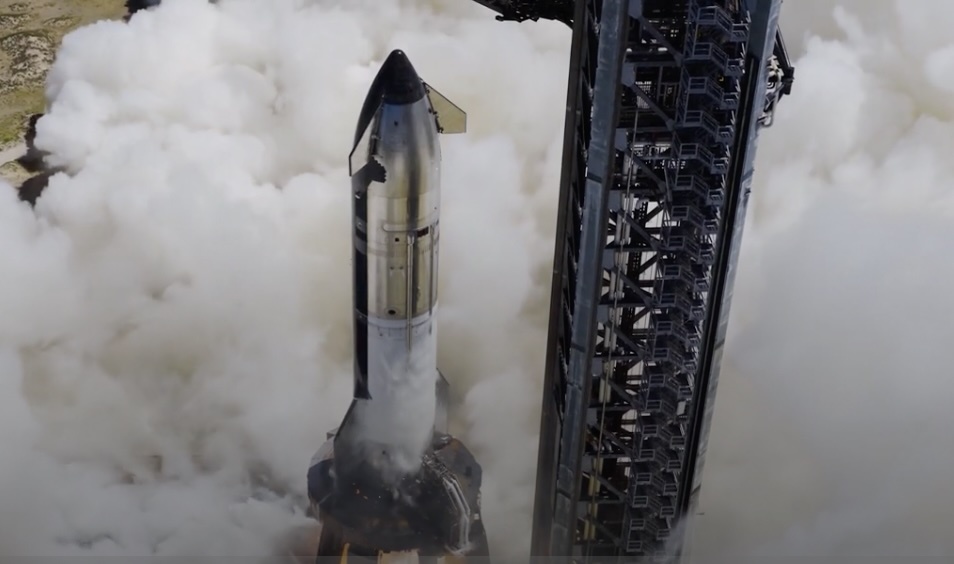
SpaceX is continuing to gear up for the next flight of its Starship megarocket, which may be just around the corner.
The company conducted a "static fire" test with its latest Starship upper stage recently, firing up its six Raptor engines while the vehicle remained anchored to the launch mount at SpaceX's Starbase site in South Texas.
The milestone, which SpaceX announced via X on Monday evening (Sept. 22), is part of the prep work for Starship's 11th test flight. The company has already static-fired the Super Heavy first-stage booster that will fly on that mission.
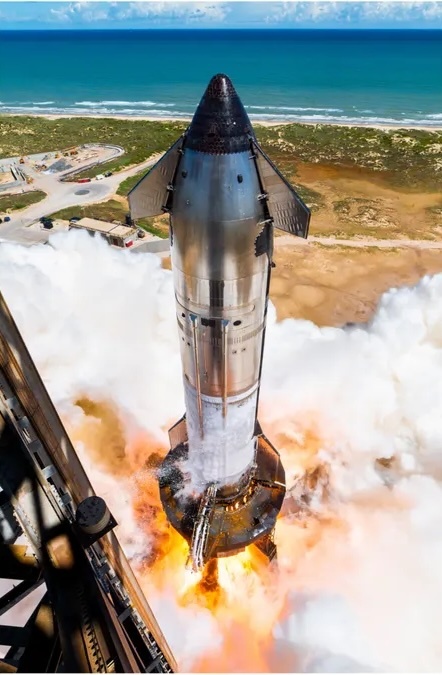
SpaceX conducts a static fire test with the upper stage of its Flight 11 Starship vehicle at Starbase in South Texas. The company released this photo on X on Sept. 22, 2025. (Image credit: SpaceX)
SpaceX is developing Starship, the biggest and most powerful rocket ever built, to help humanity settle Mars and embark on other exploration tasks. Both of its elements — Super Heavy and the upper-stage spacecraft, known as Starship or simply "Ship" — are designed to be fully and rapidly reusable.
Starship has flown in its stacked configuration 10 times to date, most recently on Aug. 26. That test launch was a success; both Super Heavy and Ship splashed down in their target zones (the Gulf of Mexico and Indian Ocean, respectively), and Ship deployed eight dummy payloads into space as planned. That had never been done before on a Starship flight.
Flight 10 was a bounce-back mission for Starship; SpaceX had lost Ship prematurely on the previous three test flights, and another one of the upper-stage vehicles exploded on the test stand this past June.
SpaceX has not yet announced a target launch date for Flight 11, which will be the final mission of Starship's current "Version 2" iteration.
The company will soon start flying Starship Version 3, an even bigger vehicle that will be capable of getting cargo and people to Mars. If all goes well with the Version 3 test campaign, the first fleet of uncrewed Starships could launch toward the Red Planet in late 2026, SpaceX founder and CEO Elon Musk has said.
Quelle: SC
----
Update: 1.10.2025
.
SpaceX targeting Oct. 13 for next Starship megarocket launch
Flight 11 will be the last launch of Starship's current "Version 2" iteration.
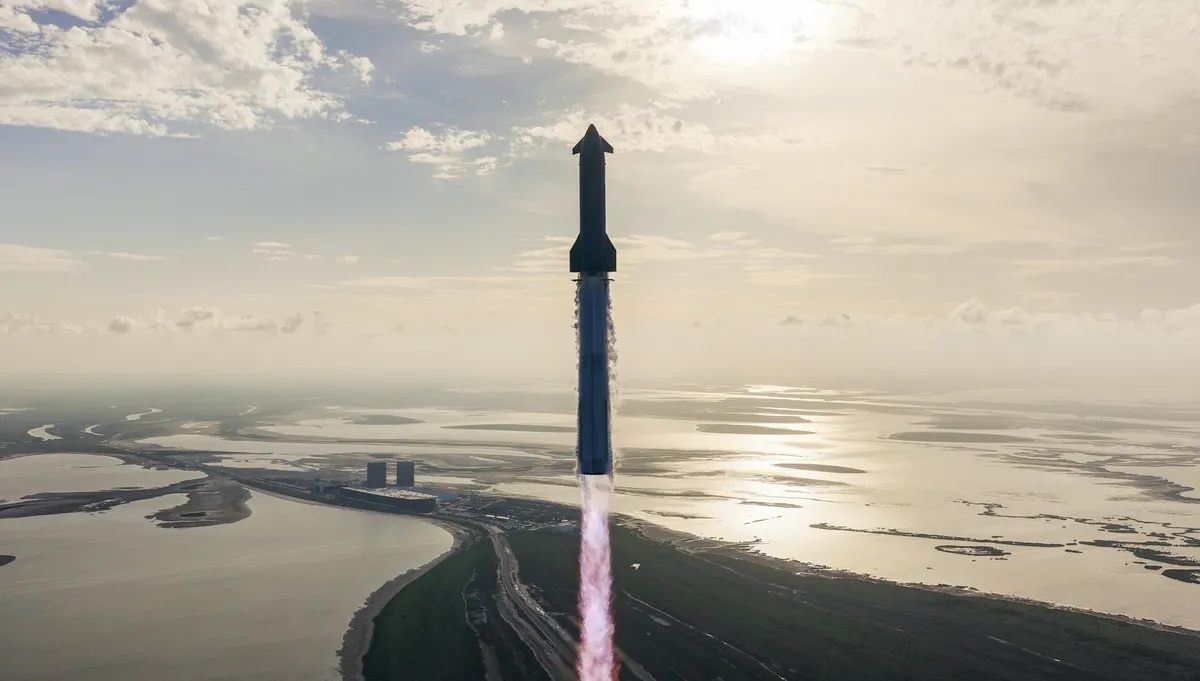
SpaceX's Starship megarocket launches on its 10th-ever test flight, on Aug. 26, 2025. (Image credit: SpaceX
SpaceX's Starship megarocket will fly again less than two weeks from now, if all goes according to plan.
SpaceX announced on Monday (Sept. 29) that it's targeting Oct. 13 for StarshipFlight 11, which will be the final launch of the vehicle's current "Version 2" iteration.
Liftoff will occur from SpaceX's Starbase site in South Texas. The window on Oct. 13 will open at 7:15 p.m. EDT (2315 GMT; 6:15 p.m. local Texas time), SpaceX wrote in an update on Monday. The company will webcast the action, beginning 30 minutes before liftoff.
SpaceX is developing Starship to help humanity settle Mars, a long-held dream of company founder and CEO Elon Musk. The vehicle consists of two stainless-steel elements, both of which are designed to be fully reusable — a first-stage booster called Super Heavy and an upper stage known as Starship, or Ship for short.
Starship Version 2 is the biggest and most powerful rocket ever built, towering nearly 400 feet (121 meters) above the ground when stacked. The next variant — Version 3, which will debut on Flight 12 — is larger still, at 408 feet (124.4 m) tall.
But the rocket will get even bigger over time, if all goes to plan: Version 4, which is expected to debut in 2027, is expected to be around 466 feet (142 m) tall.
Starship Flight 11 will be very similar to Flight 10, which lifted off on Aug. 26 and was a complete success.
On that most recent flight, Super Heavy steered itself to a splashdown in the Gulf of Mexico as planned. Ship did the same in the Indian Ocean off the west coast of Australia — but not before deploying eight dummy versions of SpaceX's Starlink internet satellites.
Flight 11 will target those same two splashdown zones, and Ship will aim to deploy another eight mock Starlinks, SpaceX wrote in Monday's update. And, as on Flight 10, SpaceX will remove some heat-shield tiles from Ship "to intentionally stress-test vulnerable areas across the vehicle."
Super Heavy, meanwhile, will demonstrate "a unique landing burn engine configuration planned to be used on the next generation Super Heavy." That plan calls for the booster to use five of its 33 Raptor engines to fine-tune its descent instead of the usual three, "adding additional redundancy for spontaneous engine shutdowns." The five-engine fine-tuning burn will be the baseline for Version 3 of Super Heavy, SpaceX wrote in the update.
And Flight 11 will be the second launch for this particular booster. It also completed Flight 8 this past March, coming back to Starbase for a catch by the "chopstick" arms of the launch tower — the planned recovery strategy for both Super Heavy and Ship on operational launches. Twenty-four of the Flight 11 Super Heavy's 33 Raptors are flight-proven, according to SpaceX.
This will be the second reuse of a Super Heavy. SpaceX also employed a flight-proven booster on Flight 9, which launched on May 27.
Quelle: SC
----
Update: 9.10.2025
.
STARSHIP'S ELEVENTH FLIGHT TEST
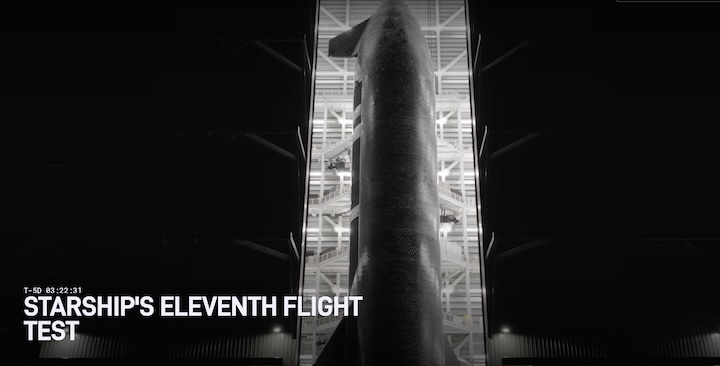
The eleventh flight test of Starship is preparing to launch as soon as Monday, October 13. The launch window will open at 6:15 p.m. CT.
A live webcast of the flight test will begin about 30 minutes before liftoff, which you can watch here and on X @SpaceX. You can also watch the webcast on the X TV app. As is the case with all developmental testing, the schedule is dynamic and likely to change, so be sure to check in here and stay tuned to our X account for updates.
The upcoming flight will build on the successful demonstrations from Starship’s tenth flight test with flight experiments gathering data for the next generation Super Heavy booster, stress-testing Starship’s heatshield, and demonstrating maneuvers that will mimic the upper stage’s final approach for a future return to launch site.
The booster on this flight test previously flew on Flight 8 and will launch with 24 flight-proven Raptor engines. Its primary test objective will be demonstrating a unique landing burn engine configuration planned to be used on the next generation Super Heavy. It will attempt this while on a trajectory to an offshore landing point in the Gulf of America and will not return to the launch site for catch.
Super Heavy will ignite 13 engines at the start of the landing burn and then transition to a new configuration with five engines running for the divert phase. Previously done with three engines, the planned baseline for V3 Super Heavy will use five engines during the section of the burn responsible for fine-tuning the booster’s path, adding additional redundancy for spontaneous engine shutdowns. The booster will then transition to its three center engines for the end of the landing burn, entering a full hover while still above the ocean surface, followed by shutdown and dropping into the Gulf of America. The primary goal on the flight test is to measure the real-world vehicle dynamics as engines shut down while transitioning between the different phases.
The Starship upper stage will target multiple in-space objectives, including the deployment of eight Starlink simulators, similar in size to next-generation Starlink satellites. The Starlink simulators will be on the same suborbital trajectory as Starship and are expected to demise upon entry. A relight of a single Raptor engine while in space is also planned.
The flight test includes several experiments and operational changes focused on enabling Starship’s upper stage to return to the launch site on future flights. For reentry, tiles have been removed from Starship to intentionally stress-test vulnerable areas across the vehicle. Several of the missing tiles are in areas where tiles are bonded to the vehicle and do not have a backup ablative layer. To mimic the path a ship will take on future flights returning to Starbase, the final phase of Starship’s trajectory on Flight 11 includes a dynamic banking maneuver and will test subsonic guidance algorithms prior to a landing burn and splashdown in the Indian Ocean.
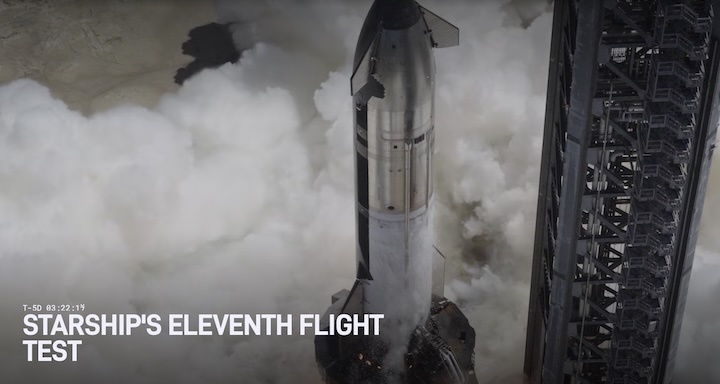
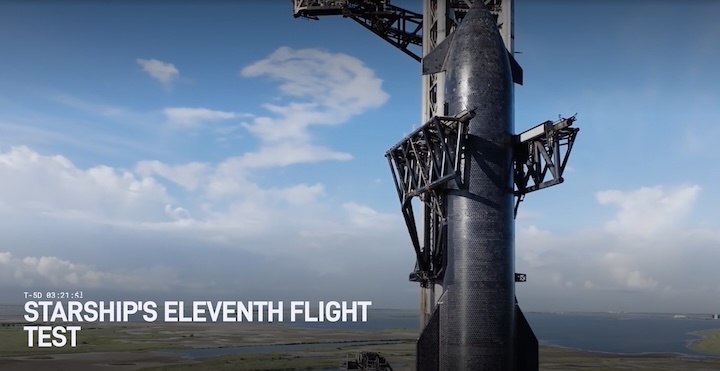
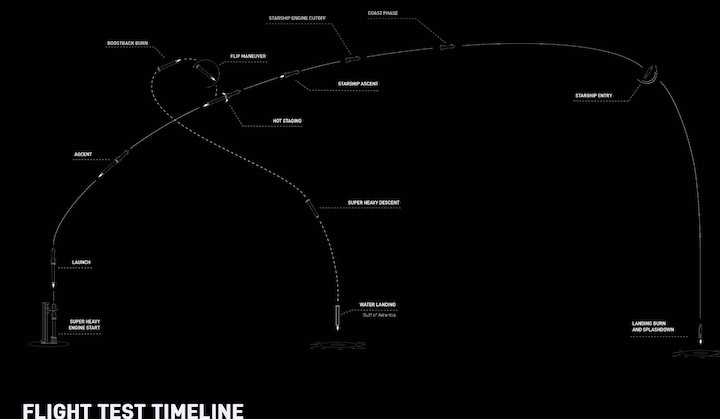
Quelle: SpaceX
----
Update: 13.10.2025
.
SpaceX Starship launches could bring huge tourist crowds, economic boost to Space Coast
SOUTH PADRE ISLAND, Texas — Despite the COVID-19 pandemic, an estimated 220,000 spectators still swarmed Space Coast beachside and riverfront rocket-viewing sites in May 2020 to see America's first crewed launch since the end of the space shuttle program — though NASA had urged people to stay home and watch on TV instead.
Experts say similar crowds could converge for SpaceX's historic initial launches of Starship-Super Heavy — the most powerful rocket system in world history — from NASA's Kennedy Space Center and Cape Canaveral Space Force Station.
“Just given the size of it and the curiosity of the thing, I think the crowds could be similar to the old days of the shuttle launches," said Don Platt, director of the Florida Institute of Technology's Spaceport Education Center in Titusville.
“There’s going to be a huge buzz about something that big. Especially with the unknowns about it, and just the overall thing about it being ‘the Mars rocket,’ “ Platt said.
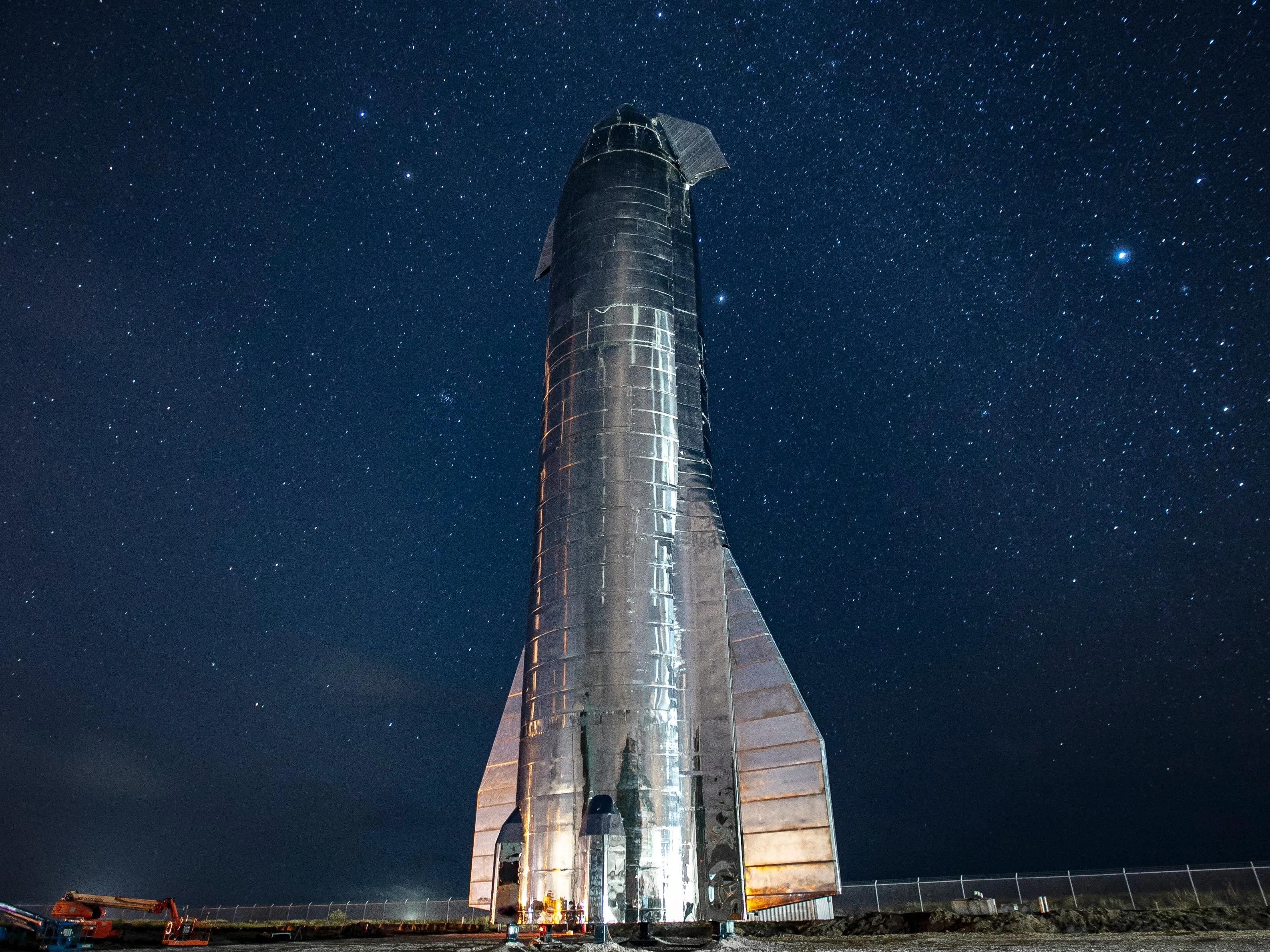
SpaceX
In the meantime, SpaceX crews are prepping to launch the 11th Starship flight test from Boca Chica, Texas. The launch window opens at 7:15 p.m. EST Monday, Oct. 13. Towering more than 400 feet high, the Starship rocket and Super Heavy booster surpass even the Saturn V that transported NASA's Apollo astronauts to the moon.
In Florida, SpaceX is seeking regulatory and environmental approvals to start launching up to 44 Starship-Super Heavy tandems per year from KSC, along with up to 76 annual launches from adjacent Cape Canaveral Space Force Station.
When? Construction is underway on Starship facilities at the Cape and no Florida timetable has been set. During an Aug. 22 Space Coast Symposium speech, SpaceX Vice President of Launch Kiko Dontchev said "you're going to get a vetted machine that shows up ready to party."
"There's some thought like, 'We're just kind of rushing into this Starship-in-Florida thing.' But we've actually been working on this problem for maybe six or seven years now," Dontchev told the audience.
Space Coast Office of Tourism data shows high-profile launches boost Brevard County's economy: think lodging, dining and beverages, recreation and entertainment, and retail shopping. The agency's launch crowd estimates are based on cellphone GPS data.
The heavily attended May 2020 Demo-2 liftoff launched on a Saturday afternoon, drawing cheering crowds chanting "USA! USA!" to the Westgate Cocoa Beach Pier and other locales. A SpaceX Falcon 9 rocket and Dragon spacecraft carried NASA astronauts Robert Behnken and Douglas Hurley to the ISS from American soil for the first time since 2011.
Other milestone missions, such as NASA's November 2022 Artemis I moon-rocket launch from KSC, tend to draw 100,000 to 200,000 visitors, Space Coast Office of Tourism spokesperson Meagan Happel said. A large throng watched that mighty Artemis I rocket liftoff, even though it rumbled off the pad at 1:47 a.m. on a Wednesday.
Happel said crowd estimates do not include local residents who watched those launches at popular viewing sites; children who do not have cellphones; or people with international phones.
A 2023 Space Coast Office of Tourism survey of overnight visitors who primarily traveled to Brevard to see a launch showed the average party size was 2.8 people; average length of stay was 4.8 nights (scrubs may have been a factor); and each visitor spent an average of $231 per day. Average spending per party: $3,101.
Rocket launch visitors primarily visited Cocoa Beach-Cape Canaveral(42%) and Titusville (23%), with Melbourne Beach-South Beaches ranking third at 9%.
Beyond tourism, state officials estimate SpaceX bringing Starships to Florida's Space Coast will create at least $1.8 billion of infrastructure investment and about 600 new full-time jobs by 2030.
On Sept. 3, the Federal Aviation Administration conducted a virtual public meeting on potential Starship environmental impacts at pad 39A at KSC. That's when photographer Max West, who has a YouTube channel and described himself as "pro-SpaceX," said he plans to move to Florida in the coming years to capture images of Starship launches.
"I can't wait. It's a job for me. And it's bringing a lot more jobs down to the Florida area. And I say that more launches would be nice," West said.
South Padre Island promoting Starship launches
By contrast, rocket launches remain novelty events in sparsely populated, southernmost Texas, where SpaceX continues developing its massive Starship manufacturing and launch facilities in Boca Chica.
Here, the remote Rio Grande Valley lacks the generations of rocketry history accumulated on Florida's NASA-centric Space Coast. The primary Starship launch viewing area for spectators is South Padre Island. Reminiscent of a mini-Cocoa Beach in many respects, the barrier-island resort town lined with oceanfront condominiums is home to about 2,100 permanent residents across 3.7 square miles.
Launch-viewing statistics rank on a micro-scale compared with Brevard. During the five-day span from Oct. 11-15, 2024, an estimated 20,660 people came to town for Starship's landmark fifth flight test, per Visit South Padre Island data based on cellphone GPS data.
Visitation peaked just shy of 7,000 people on the Oct. 13, 2024, launch date, which was a Sunday morning. That's when SpaceX crews made history when the "Mechazilla" catch tower's metal arms caught a Super Heavy booster for the first time.
The overwhelming number of those visitors (18,835) were Texas residents. Most lived in the surrounding Rio Grande Valley (13,365 people), with San Antonio (1,349), Dallas-Fort Worth (1,029) and Houston (949) leading the "drive-market" cities. San Antonio, the closest of the three, is about a 4½-hour drive away.
"That boost in the local economy supports jobs, supports our island businesses," April Romero, Visit South Padre Island director of communications, said during an interview in her office.
"We've seen a lot more of our partners install private Tesla chargers, just because we're seeing an influx of more Teslas on the island. So it's little things like that we can tell that SpaceX is making an impact, not just on the local economy but on infrastructure being changed," Romero said.
Visit South Padre Island is touting Starship launches via promotional videos and social media, and the organization created a SpaceX launch viewing webpage. The organization recommends tourists to stay in town at least four days.
"We've seen a lot more SpaceX employees coming and visiting and staying on South Padre Island that hadn't even heard of this destination before. So SpaceX has put us on a global spotlight," Romero said.
Starship spectator stays in Texas, launches space company
In a 2021 personal move, space fan Paul Mamakos sold his Virginia home and decided "maybe it's time to make a change, rather than just watch from the sidelines." That March, he migrated to Boca Chica and spent a couple years filming and editing more than 1,900 videos of SpaceX's Starship and Starbase-building activities — with some videos garnering hundreds of thousands of YouTube views.
Mamakos, a former NASA Ames Research Center intern and entrepeneur who founded a natural foods company, recalled how he started seriously thinking about moons with subsurface oceans during an inspirational walk past SpaceX's futuristic facilities at Starbase. After conducting research and interviewing planetary scientists, he founded Space Ocean Corp., a tech startup aiming to extract and store water from those moons to supply deep-space missions.
Settling in, he moved into a recreational vehicle at the rural 13-acre Maker SpaceX Boca Chica ranch in November 2024 roughly 17 miles from Starbase. Since then, Space Ocean Corp. has formed a board of directors and inked letters of intent with a trio of fellow space exploration companies, with an eye set on developing in-space satellite refueling technology.
Chatting outside his RV at the ranch amid buzzing insects, Mamakos discussed space logistics near a 30-foot-tall aluminum-tubing art installation shaped like a SpaceX Starship nose cone. The sculpture sits on a small round island in a surrounding marsh. He gestured at nearby lily pads and aquatic vegetation.
"If we were to collect this water and launch it into orbit, and provide it as a resource around Mars — that's what we're trying to do," Mamakos said.
Back in the Sunshine State, Greg Autry is the associate provost for space commercialization and strategy at the University of Central Florida. He called Starship a key piece of an upcoming Cape Canaveral launch boom that will include United Launch Alliance's Vulcan rockets, Blue Origin's New Glenn rockets, Firefly Aerospace and others — plus NASA's Artemis program is rolling along.
"It's just a lot of launches. I think that's going to be huge excitement for the Space Coast. And I think we'll see another kind of economic boom like we saw a few years ago that drove up housing prices and everything else," Autry said
"I know that won't make everybody happy," he said, laughing. "But I think it's, overall, going to be an amazing thing for Central Florida."
Among that next generation of rockets, Autry said Starship is "taking it to a whole nother level" of payload volume, potential economic development, and excitement from the public.
Commissioner: 'What we seek is a reasonable middle ground'
Platt noted a key crowd difference between the shuttle days and today: Cape Canaveral's dizzying launch rate has made most liftoffs seem routine to local residents. With orbital launches already up in the mid-80s this year, Florida's Space Coast stands poised to blow past 2024's short-lived record of 93 annual launches.
For example, Platt said NASA's SpaceX Crew-11 launch on Aug. 1 that sent four crew members to the ISS generated little buzz — and neither do SpaceX's Falcon 9 rockets that lift off at 3 a.m. or 4 a.m. But he said Starship should be a different beast.
Coupled with record-breaking launch activity at the Cape, the pending Starship-Super Heavy arrival at KSC generated hundreds of written statements from the public to the FAA. The overwhelming majority expressed concerns about an array of potential environmental impacts — particularly projected delays at Florida airports and Playalinda Beach closures at Canaveral National Seashore.
In a letter to the FAA, Brevard County Commissioner Katie Delaney said numerous businesses operating in and around KSC — including aerospace contractors, support vendors and marine-based operators — have reported operational disruptions tied directly to intensified launch cadence. These impacts include:
- Delayed or limited access to worksites because of expanded restricted zones.
- Interruptions to manufacturing, research and supply-chain activities from sudden launch rescheduling.
- Interference with coastal and marine operations caused by repeated maritime exclusion zones.
- Loss of productivity and revenue during extended safety stand-downs or access limitations.
Delaney asked the FAA to conduct a comprehensive review of the cumulative environmental, social and economic impacts of increasing launch frequencies in Brevard. She also requested a formal coordination framework with local governments, business leaders and affected communities.
"Of course, I support the space industry. I just really feel like there should be some balance between the quality of life and supporting this industry that's so important to our community," Delaney said during the commission's Sept. 23 final budget hearing.
Delaney said she hopes to find "a happy medium" between Starship operations and her District 1 concerned constituents.
During that discussion, Brevard County Commissioner Thad Altman said he fully supports SpaceX: "The more rockets launched and the bigger, the better."
Altman said Wernher von Braun, the pioneering German rocket scientist who became chief architect of NASA's Saturn V moon rocket, envisioned three Vehicle Assembly Buildings rather than today's single 525-foot facility at KSC. Altman noted that rockets are taking flight in Virginia, Texas, New Mexico and Kwajalein Atoll, but Brevard's infrastructure and geographic location make it uniquely qualified to launch large rockets.
"If we're going to survive as a Space Coast, I think we need to support this effort to launch large rockets," Altman said.
Quelle: Florida Today
